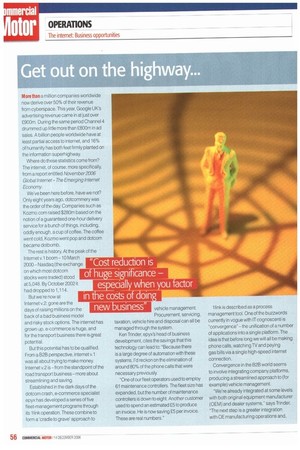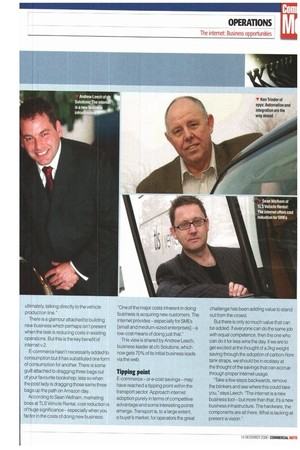Get out on the highway...
Page 56

Page 57

If you've noticed an error in this article please click here to report it so we can fix it.
More than a million companies worldwide now derive over 50% of their revenue from cyberspace. This year, Google UK's advertising revenue came in at just over £900m. During the same period Channel 4 drummed up little more than £800m in ad sales. A billion people worldwide have at least partial access to internet, and 16% of humanity has both feet firmly planted on the information superhighway.
Where do these statistics come from? The internet, of course; more specifically, from a report entitled November 2006 Global InternetThe Emerging Internet Economy.
We've been here before, have we not? Only eight years ago, dotcommery was the order of the day. Companies such as Kozmo,com raised $280m based on the notion of a guaranteed one-hour delivery service for a bunch of things, including, oddly enough, a cup of coffee. The coffee went cold, Kozmo went pop and dotcom became dotbomb.
The rest is history. At the peak of the Internet v.1 boom10 March 2000Nasdaq (the exchange on which most dotcom stocks were traded) stood at 5,048. By October 2002 it had dropped to 1,114.
But we're now at Internet v.2: gone are the days of raising millions on the back of a bad business model and risky stock options. The internet has grown up, e-commerce is huge, and for the transport business there is.great potential.
But this potential has to be qualified. From a B2B perspective, interne' v.1 was all about trying to make money. Internet v.2 is from the standpoint of the road transport business more about streamlining and saving.
Established in the dark days of the dotcom crash, e-commerce specialist epyx has developed a series of five fleet-management programs through its llink operation. These combine to form a 'cradle to grave' approach to vehicle management. Procurement. servicing, taxation, vehicle hire and disposal can all be managed through the system.
Ken Trinder, epyx's head of business development, cites the savings that this technology can lead to: "Because there is a large degree of automation with these systems, I'd reckon on the elimination of around 80% of the phone calls that were necessary previously, "One of our fleet operators used to employ 61 maintenance controllers. The fleet size has expanded. but the number of maintenance controllers is down to eight. Another customer used to spend an estimated £5 to produce an invoice. He is now saving £5 per invoice. These are real numbers." 1Iink is described as a process management tool. One of the buzzwords currently in vogue with IT cognoscenti is "convergence" -the unification of a number of applications into a single platform. The idea is that before long we will all be making phone calls, watching TV and paying gas bills via a single high-speed Internet connection.
Convergence in the B2B world seems to involve integrating company platforms, producing a streamlined approach to (for example) vehicle management.
"We're already integrated at some levels with both original equipment manufacturer (OEM) and dealer systems," says Trinder. "The next step is a greater integration with OE manufacturing operations and, ultimately, talking directly to the vehicle production line."
There is a glamour attached to building new business which perhaps isn't present when the task is reducing costs in existing operations. But this is the key benefit of Internet v.2.
E-commerce hasn't necessarily added to consumption but it has substituted one form of consumption for another. There is some guilt attached to dragging three bags out of your favourite bookshop; less so when the post lady is dragging those same three bags up the path on Amazon day.
According to Sean Welham, marketing boss at TLS Vehicle Rental, cost reduction is of huge significance especially when you factor in the costs of doing new business: "One of the major costs inherent in doing business is acquiring new customers. The internet providesespecially for SMEs [small and medium-sized enterprises] a low-cost means of doing just that."
This view is shared by Andrew Leech, business leader at cfc Solutions, which now gets 70% of its initial business leads via the web.
Tipping point
E-commerce or e-cost savingsmay have reached a tipping point within the transport sector. Approach internet adoption purely in terms of competitive advantage and some interesting points emerge. Transport is, to a large extent, a buyer's market; for operators the great challenge has been adding value to stand out from the crowd.
But there is only so much value that can be added. If everyone can do the same job with equal competence, then the one who can do it for less wins the day. If we are to get excited at the thought of a 2kg weight saving through the adoption of carbon-fibre tank straps, we should be in ecstasy at the thought of the savings that can accrue through proper internet usage.
"Take a few steps backwards, remove the blinkers and see where this could take you," says Leech. "The internet is a new business tool but more than that, it's a new business infrastructure. The hardware, the components are all there, What is lacking at present is vision."
















































































































































































